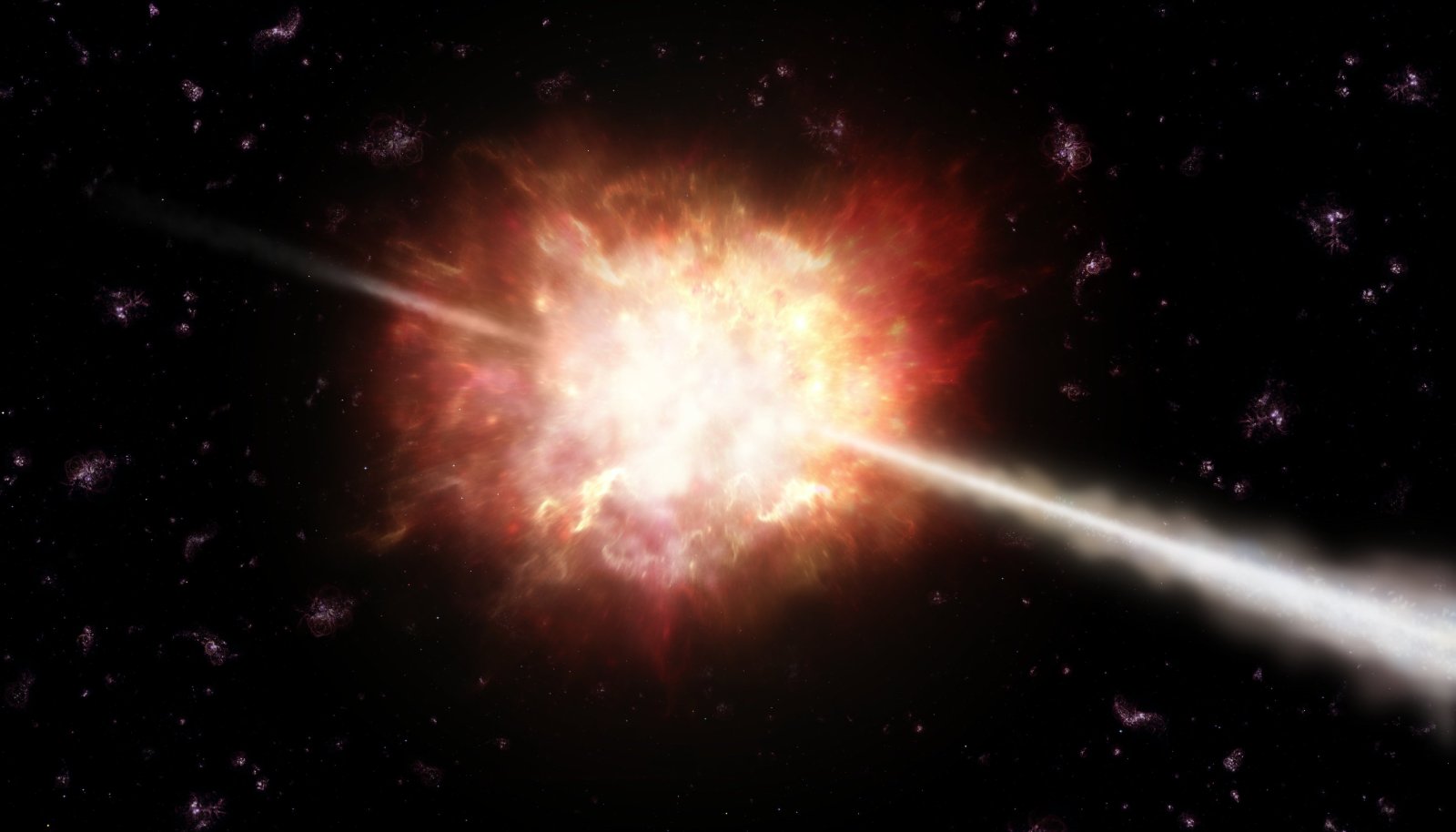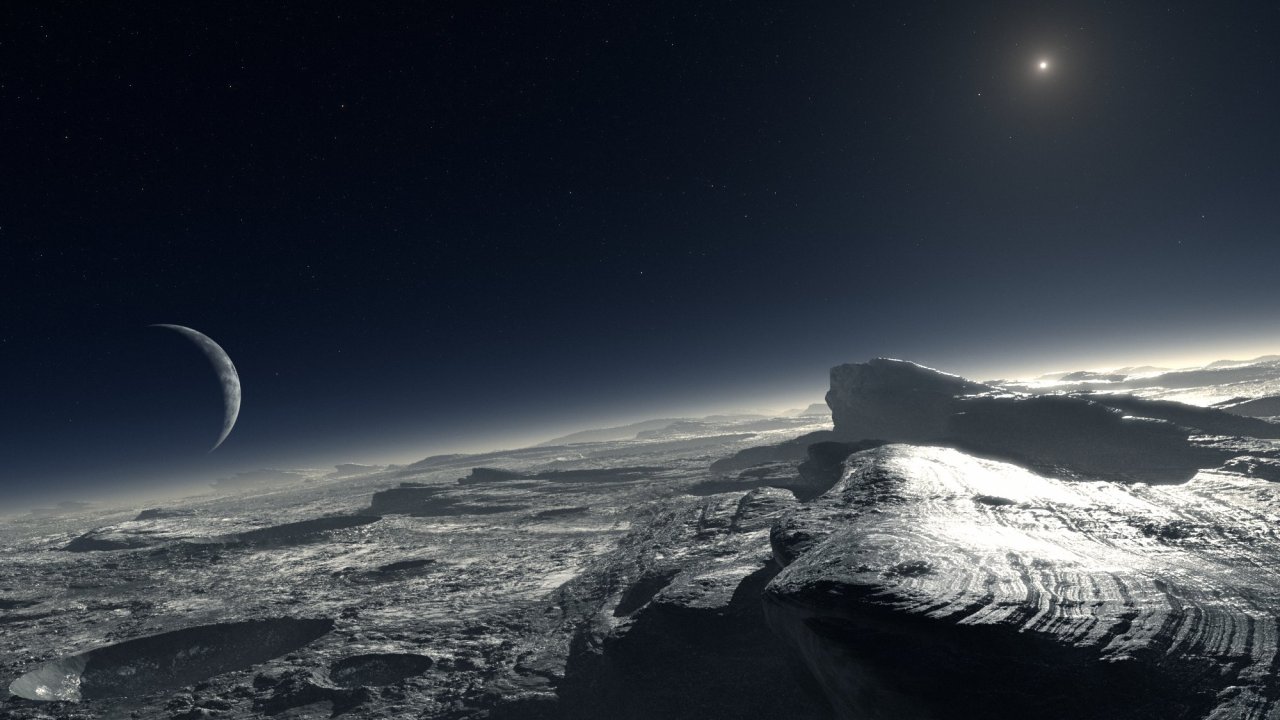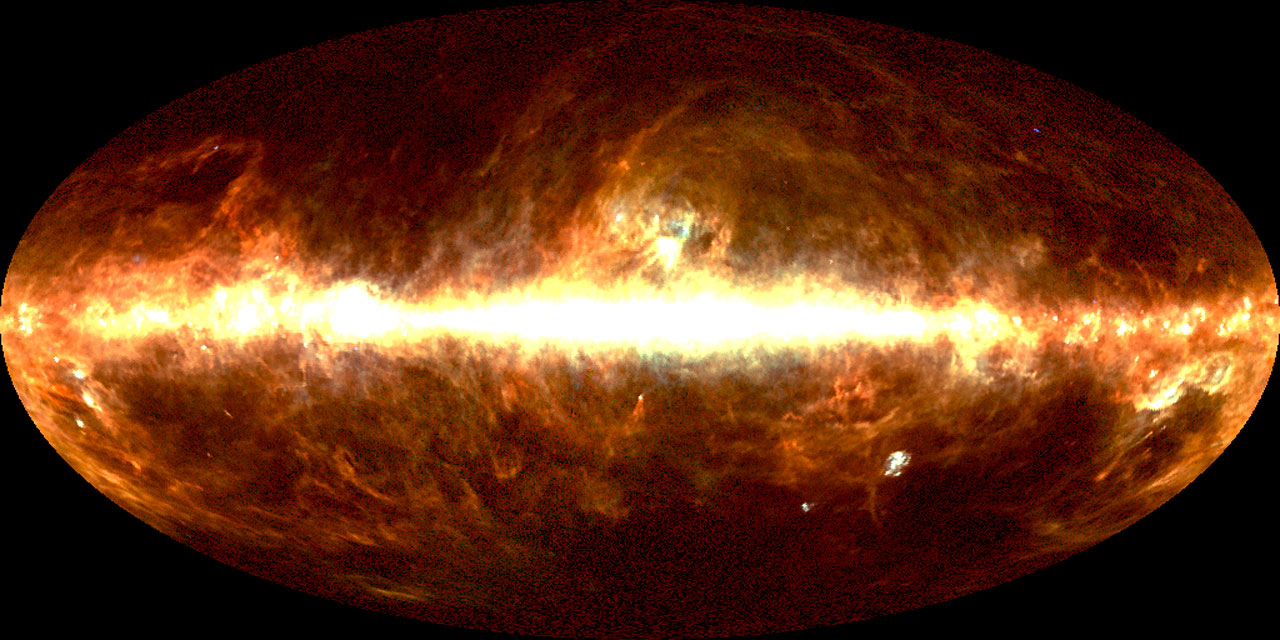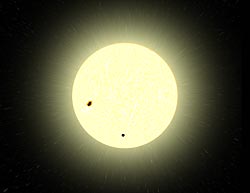Stern explodiert zu Schwarzem Loch, nur 600 Millionen Jahre nach dem Urknall! Beobachtet am 23.4. als Gammablitz und dann im IR - Licht. Pressemitteilung der ESO in Englisch und der dpa in Deutsch.
ESO 17/09 - Science Release
28 April 2009
The Most Distant Object Yet Discovered in the Universe
ESO's Very Large Telescope has shown that a faint gamma-ray burst detected last Thursday is the signature of the explosion of the earliest, most distant known object in the Universe (a redshift of 8.2). The explosion apparently took place more than 13 billion years ago, only about 600 million years after the Big Bang.
Gamma-ray bursts (GRBs) are powerful flashes of energetic gamma-rays lasting from less than a second to several minutes. They release a tremendous amount of energy in this short time making them the most powerful events in the Universe. They are thought to be mostly associated with the explosion of stars that collapse into black holes.
The gamma-ray burst GRB 090423 was detected by the NASA/STFC/ASI Swift satellite during the morning (CEST) of Thursday 23 April 2009. The 10 second burst was located in the constellation of Leo (the Lion). It was soon being followed by a whole range of telescopes on the ground, including the 2.2-metre ESO/MPG telescope at La Silla and ESO’s Very Large Telescope (VLT) at Paranal, both in Chile.
VLT infrared observations, made 17 hours after the burst detection, allowed astronomers to establish the distance to the explosion. “We find that the light coming from the explosion has been stretched, or redshifted, considerably by the expansion of the Universe”, says Nial Tanvir, the leader of the team who made the VLT observations. “With a redshift of 8.2 this is the most remote gamma-ray burst ever detected, and also the most distant object ever discovered — by some way.”
Because light moves at a finite speed, looking farther into the Universe means looking back in time. The explosion occurred when the Universe was about 600 million years old, less than 5 percent of its current age. It is believed that the very first stars only formed when the Universe was between 200 and 400 million years old.
“This discovery proves the importance of gamma-ray bursts in probing the most distant parts of the Universe”, says Tanvir. “We can now be confident that even more remote bursts will be found in the future, which will open a window to studying the very first stars and the ultimate end of the Dark Age of the Universe.”
The previous record holder for the most distant GRB — first detected by Swift last year and then also studied with the VLT — had a redshift of 6.7 [1]. The blast, designated GRB 080913, arose from a star exploding about 200 million years after GRB090423. The previous most distant object known in the Universe confirmed spectroscopically is a galaxy with a redshift of 6.96 [2].
More information
The ISAAC observations at the VLT were done on behalf of an international collaboration by N. Tanvir (U. Leicester, UK), A. Levan (U. Warwick, UK), K. Wiersema (U. Leicester, UK), J. Fynbo and J. Hjorth (Dark Cosmology Centre, Copenhagen, Denmark), and P. Jakobsson (Reykjavik, Iceland).
The GROND observations with the 2.2-metre ESO/MPG telescope at La Silla were made by F. Olivares, T. Krühler, J. Greiner and R. Filgas (Max Planck Institute for Extraterrestrial Physics, Garching, Germany).
Gamma-ray bursts are discovered by telescopes in space. After releasing their intense burst of high-energy radiation, they become detectable for a short while in the optical and in the near-infrared. This ‘afterglow’ fades very rapidly, making detailed analysis possible for only a few hours after the gamma-ray detection. This analysis is important in particular in order to determine the GRB's distance and, hence, intrinsic brightness.
Gamma-ray bursts are the universe's most luminous explosions. Most occur when massive stars run out of nuclear fuel. As their cores collapse into a black hole or neutron star, gas jets — driven by processes not fully understood — punch through the star and blast into space. There, they strike gas previously shed by the star and heat it, which generates short-lived afterglows in many wavelengths.
Notes
[1] See http://www.nasa.gov/mission_pages/swift/bursts/farthest_grb.html
[2] See https://www.naoj.org/Pressrelease/2006/09/13/index.html
ESO, the European Southern Observatory, is the foremost intergovernmental astronomy organisation in Europe. It is supported by 14 countries: Austria, Belgium, the Czech Republic, Denmark, France, Finland, Germany, Italy, the Netherlands, Portugal, Spain, Sweden, Switzerland and the United Kingdom. ESO carries out an ambitious programme focused on the design, construction and operation of powerful ground-based observing facilities enabling astronomers to make important scientific discoveries. ESO also plays a leading role in promoting and organising cooperation in astronomical research. ESO operates three unique world-class observing sites in the Atacama Desert region of Chile: La Silla, Paranal and Chajnantor.
Sternenforscher entdecken fernstes Objekt im All
Garching (dpa) - Sternenforscher haben das bislang fernste Objekt im All erspäht. Am 23. April 2009 wurde ein schwacher Gammastrahlenblitz beobachtet, wie die Europäische Südsternwarte (ESO) am 28. April in Garching bei München bekanntgab. Das sei eine Spur der Explosion des frühesten und am weitesten entfernten Objekts im Weltall, das je beobachtet worden sei. Die Explosion habe sich in mehr als 13 Milliarden Lichtjahren Entfernung ereignet und gerade einmal 600 Millionen Jahre nach dem Urknall. Mit dem NASA-Satelliten «Swift» wurde die zehnsekündige Erscheinung im Sternbild Löwen entdeckt. Zahlreiche Astronomen verfolgten laut ESO das kosmische Spektakel von irdisch stationierten Teleskopen aus.
Die ESO selbst beobachtete die Explosion unter anderem mit ihrem Very Large Telescope (VLT) auf dem Cerro Paranal in Chile. Rund 17 Stunden später haben die Astronomen anhand der Infrarot-Aufnahmen des VLT die Entfernung der Explosion zur Erde berechnen können. Sie hätten herausgefunden, dass das Licht der Explosion erheblich von der Ausdehnung des Weltalls gestreckt worden sei, sagte Nial Tanvir, der Chef des Teams, das die Beobachtungen gemacht hatte.
Da sich das Licht mit einer endlichen Geschwindigkeit bewege, sei ein Blick in die Tiefen des Universums stets auch ein Blick zurück in die Vergangenheit. «Wir können sicher sein, dass künftig noch abgelegenere Explosionen entdeckt werden, die ein Fenster zum Studium der ersten Sterne und dem Ende des Dunklen Zeitalters des Universums öffnen», sagte Tanvir weiter. Als Dunkles Zeitalter bezeichnen Kosmologen die Ära vor dem Aufleuchten der ersten Sterne im jungen Universum.
Gammastrahlenblitze wie der beobachtete seien starke Explosionen, die von wenigen Sekunden bis zu einigen Minuten andauern können. Sie setzen laut ESO in dieser kurzen Zeit eine enorme Energie frei, so dass sie als energiereichste Erscheinungen im All eingestuft werden. Deshalb würden sie mit der Explosion von Sternen in Verbindung gebracht, die dann zu Schwarzen Löchern kollabieren. Das zuvor fernste bekannte Objekt im Weltall - ebenfalls ein explodierter Stern - ist den Angaben nach 200 Millionen Lichtjahre näher als das nun entdeckte.
Weitere Infos:
- Europäische Südsternwarte:
http://www.eso.org
- Plutos Atmosphäre friert ein, wenn Pluto im sonnenfernsten Teil seiner elliptischen Bahn ist. Zur Zeit steht Pluti der Sonne etwas näher und das Eis verdampft und bildet eine Atmosphäre aus Stickstoff und Methan.
- Durch Sternbedeckungen konnte die Atmosphäre genauer untersucht werden: Ihre Temperatur steigt nach oben (auf -170° C). Durch die Verdunstungskälte ist die Temperatur der Oberfläche nur -220° C.
Hier die ESO Pressemeldung:
The lower atmosphere of Pluto revealed
Using ESO's Very Large Telescope, astronomers have gained valuable new insights about the atmosphere of the dwarf planet Pluto. The scientists found unexpectedly large amounts of methane in the atmosphere, and also discovered that the atmosphere is hotter than the surface by about 40 degrees, although it still only reaches a frigid minus 180 degrees Celsius. These properties of Pluto's atmosphere may be due to the presence of pure methane patches or of a methane-rich layer covering the dwarf planet's surface.
"With lots of methane in the atmosphere, it becomes clear why Pluto's atmosphere is so warm," says Emmanuel Lellouch, lead author of the paper reporting the results.
Pluto, which is about a fifth the size of Earth, is composed primarily of rock and ice. As it is about 40 times further from the Sun than the Earth on average, it is a very cold world with a surface temperature of about minus 220 degrees Celsius!
It has been known since the 1980s that Pluto also has a tenuous atmosphere [1], which consists of a thin envelope of mostly nitrogen, with traces of methane and probably carbon monoxide. As Pluto moves away from the Sun, during its 248 year-long orbit, its atmosphere gradually freezes and falls to the ground. In periods when it is closer to the Sun — as it is now — the temperature of Pluto's solid surface increases, causing the ice to sublimate into gas.
Until recently, only the upper parts of the atmosphere of Pluto could be studied. By observing stellar occultations (ESO 21/02), a phenomenon that occurs when a Solar System body blocks the light from a background star, astronomers were able to demonstrate that Pluto's upper atmosphere was some 50 degrees warmer than the surface, or minus 170 degrees Celsius. These observations couldn't shed any light on the atmospheric temperature and pressure near Pluto's surface. But unique, new observations made with the CRyogenic InfraRed Echelle Spectrograph (CRIRES), attached to ESO's Very Large Telescope, have now revealed that the atmosphere as a whole, not just the upper atmosphere, has a mean temperature of minus 180 degrees Celsius, and so it is indeed "much hotter" than the surface.
In contrast to the Earth's atmosphere [2], most, if not all, of Pluto's atmosphere is thus undergoing a temperature inversion: the temperature is higher, the higher in the atmosphere you look. The change is about 3 to 15 degrees per kilometre. On Earth, under normal circumstances, the temperature decreases through the atmosphere by about 6 degrees per kilometre.
"It is fascinating to think that with CRIRES we are able to precisely measure traces of a gas in an atmosphere 100 000 times more tenuous than the Earth's, on an object five times smaller than our planet and located at the edge of the Solar System," says co-author Hans-Ulrich Käufl. "The combination of CRIRES and the VLT is almost like having an advanced atmospheric research satellite orbiting Pluto."
The reason why Pluto's surface is so cold is linked to the existence of Pluto's atmosphere, and is due to the sublimation of the surface ice; much like sweat cools the body as it evaporates from the surface of the skin, this sublimation has a cooling effect on the surface of Pluto. In this respect, Pluto shares some properties with comets, whose coma and tails arise from sublimating ice as they approach the Sun.
The CRIRES observations also indicate that methane is the second most common gas in Pluto's atmosphere, representing half a percent of the molecules. "We were able to show that these quantities of methane play a crucial role in the heating processes in the atmosphere and can explain the elevated atmospheric temperature," says Lellouch.
Two different models can explain the properties of Pluto's atmosphere. In the first, the astronomers assume that Pluto's surface is covered with a thin layer of methane, which will inhibit the sublimation of the nitrogen frost. The second scenario invokes the existence of pure methane patches on the surface.
"Discriminating between the two will require further study of Pluto as it moves away from the Sun," says Lellouch. "And of course, NASA's New Horizons space probe will also provide us with more clues when it reaches the dwarf planet in 2015."
Notes
[1] The atmospheric pressure on Pluto is only about one hundred thousandth of that on Earth, or about 0.015 millibars.
[2] Usually, air near the surface of the Earth is warmer than the air above it, largely because the atmosphere is heated from below as solar radiation warms the Earth's surface, which, in turn, warms the layer of the atmosphere directly above it. Under certain conditions, this situation is inverted so that the air is colder near the surface of the Earth. Meteorologists call this an inversion layer, and it can cause smog build-up.
More information
E. Lellouch et al. 2009, A&A, in press, Pluto's lower atmosphere structure and methane abundance from high-resolution spectroscopy and stellar occultations.
The team is composed of E. Lellouch, B. Sicardy, and
Die Milchstraße dreht sich schneller als angenommen
Long Beach - Unsere Milchstraße dreht sich schneller und hat viel mehr Masse als bislang gedacht. Das zeigen Präzisionsmessungen mit einem Netz aus Radioteleskopen. Erde und Sonne rasen demnach mit knapp einer Million Kilometer pro Stunde um das Zentrum unserer Heimatgalaxie. Das ist rund 160 000 Kilometer pro Stunde schneller als bisher gedacht, wie Forscher um Mark Reid vom Harvard-Smithsonian-Zentrum für Astrophysik am 5. Januar 2009 auf einer Tagung der Amerikanischen Astronomiegesellschaft (AAS) im kalifornischen Long Beach berichteten.
Die hohe Rotationsgeschwindigkeit bedeute, dass auch die Masse der Milchstraße um etwa die Hälfte größer sein muss als bisher angenommen - andernfalls würde sie auseinanderfliegen. Damit schließe unsere Heimatgalaxie zu ihrem Nachbarn in der sogenannten Lokalen Gruppe auf, der Andromeda-Galaxie. «Wir sehen die Milchstraße nicht länger als kleine Schwester der Andromeda-Galaxie», betonte Reid.
Für ihre Untersuchungen benutzten die Astronomen die zehn Radioteleskope des «Very Long Baseline Arrays» (VLBA), die über den amerikanischen Kontinent von Hawaii bis zu den Virgin Islands in der Karibik verteilt sind. Durch einen technischen Trick lassen sich diese Antennen zu einem einzigen, gigantischen Radioteleskop zusammenschalten. Das VLBA kann so über hundert Mal schärfere Bilder machen als das «Hubble»-Weltraumteleskop, allerdings in einem anderen Wellenlängenbereich. Das entspreche der Fähigkeit, von New York aus eine Zeitung in Los Angeles lesen zu können, illustrierten die Forscher.
Mit dieser Technik nahmen die Astronomen extrem detaillierte Bilder von Regionen reichhaltiger Sternentstehung in der Milchstraße auf und untersuchten deren Eigenbewegung. «Diese neuen VLBA- Beobachtungen der Milchstraße produzieren hochakkurate direkte Messungen der Entfernungen und Bewegungen», erläuterte das deutsche Teammitglied Karl Menten vom Max-Planck-Institut für Radioastronomie in Bonn. «Diese direkten Messungen verändern unser Verständnis der Struktur und Bewegungen unserer Galaxie.» Innerhalb der Milchstraße sei es sehr schwer, deren Struktur zu bestimmen, erläuterte Menten. «Andere Galaxien brauchen wir bloß anzuschauen und sehen ihre Struktur, bei der Milchstraße geht das nicht. Wir müssen auf ihre Struktur aus Messungen und Kartierungen rückschließen.»
dpa
News zum Schwarzen Loch im Zentrum der Galaxis: Hier klicken!
Meldung des Deutschen Zentrums für Luft- und Raumfahrt:
Der CoRoT-Satellit (Convection, Rotation and Planetary Transits) hat seinen ersten Gesteinsplaneten außerhalb unseres Sonnensystems entdeckt. Der bislang kleinste bekannte extrasolare Planet trägt den Namen CoRoT-Exo-7b und ist knapp zweimal so groß wie die Erde. Er umkreist seinen sonnenähnlichen Zentralstern in nur 20 Stunden. Das Deutsche Zentrum für Luft- und Raumfahrt (DLR) hat die On-Board-Software von CoRoT entwickelt und ist an der wissenschaftlichen Auswertung der Daten beteiligt.
"Die Entdeckung ist eine echte Sensation"
Wegen der großen Nähe zu seiner Sonne hat der Planet vermutlich eine Temperatur von mehr als 1000 Grad Celsius. Mit diesen Eigenschaften unterscheidet sich CoRoT-Exo-7b grundsätzlich von den meisten bisher entdeckten 330 Planeten, die in der Regel riesige Gasplaneten, so genannte heiße Jupiter sind. Noch kennen die Forscher die genaue Dichte von CoRoT-Exo-7b nicht, nach den bisherigen Kenntnissen könnte es ein Gesteinsplanet, ähnlich wie unsere Erde sein oder ein mit Lava bedeckter Planet. Möglich ist auch, dass er zur Hälfte aus Wasser und zur Hälfte aus Stein besteht und eine extrem heiße und dichte Wasserdampf-Atmosphäre besitzt. CoRoT-Exo-7b und sein Zentralstern sind 400 Lichtjahre von der Erde entfernt.
"Die Entdeckung eines so kleinen Planeten ist eine echte Sensation. Damit haben sich die Erwartungen, die wir in CoRoT gesetzt haben, voll erfüllt", sagt Prof. Heike Rauer, Projektleiterin CoRoT beim DLR.
Extrasolare Planetensuche aus dem All
Der erste Verdacht der Entdeckung entstand nach 40 Tagen während einer 150-tägigen Beobachtungsperiode im Winterhalbjahr 2007/2008. CoRoT sucht nach extrasolaren Planeten mit der Transitmethode. Dabei misst das Weltraumteleskop über eine längere Periode die Helligkeitsschwankungen von Sternen. Der Grund für eine solche Schwankung kann ein Planet sein, der vor der Sonne herwandert und diese minimal, aber messbar, verdunkelt. Forscher bezeichnen diese Konstellation als Planetentransit. Eine Veränderung der Helligkeit eines Sterns kann jedoch verschiedene Ursachen haben. Deshalb muss jeder Planetenkandidat, der den Forschern aus den Lichtkurvenmessungen ins Netz geht, durch mehrere Nachfolgemessungen bestätigt werden. Diese Nachfolgebeobachtungen werden von einem Netzwerk großer erdgebundener Teleskope übernommen, unter anderem auch von der Thüringer Landessternwarte in Tautenburg. Bei diesen Nachfolgemessungen haben die Forscher auch herausgefunden, dass innerhalb von acht Tagen noch ein weiterer Planet diese Sonne umkreist. Dieser hat die 14-fache Erdmasse und ist damit ein so genannter heißer Neptun. Dieser große Planet wandert von der Erde aus gesehen nie vor seinem Zentralgestern her und konnte daher nicht mit der Transitmethode nachgewiesen werden. Aufgrund seiner großen Masse wirkt seine Gravitationskraft aber auf seinen Zentralstern und die Forscher konnten die periodische Änderung der Radialgeschwindigkeit des Sterns nachweisen.
Um die Chance einer Entdeckung zu erhöhen, beobachtet CoRoT in einem Messzyklus einen Himmelsausschnitt mit mehreren Tausend Sternen. Dabei wechselt CoRoT halbjährlich die Beobachtungsrichtung. Im Winter ist der Blick in Richtung des Sternbilds Einhorn, im Sommer in die des Sternbilds Adler, in das Zentrum der Milchstraße, gerichtet.
Über CoRoT:
CoRoT startete am 27. Dezember 2006 vom Weltraumbahnhof Baikonur in Kasachstan und ist die erste Satellitenmission, die nach Gesteinsplaneten außerhalb des Sonnensystems sucht. CoRoT hat ein Teleskop mit 27 Zentimetern Öffnung an Bord und befindet sich auf einer polaren Umlaufbahn um die Erde in einer Höhe rund 900 Kilometer. Die Messtechnik von CoRoT ist nicht nur für die Transitsuche von extrasolaren Planeten geeignet, sondern ebenso für den Nachweis und die Untersuchung von Sternvibrationen.
Die Mission wird von der französischen Raumfahrtagentur CNES geleitet, beteiligt sind Forscher der ESA und anderen Forschungsinstituten aus Belgien, Brasilien, Deutschland, Österreich, Spanien. Im Auftrag der Bundesregierung und mit finanzieller Förderung des DLR-Raumfahrtmanagements wurde am DLR-Institut für Planetenforschung in Berlin innerhalb von fünf Jahren die On-Board-Software entwickelt und erprobt. Neben der Steuerung der Instrumente und der präzisen Ausrichtung des Satelliten übernimmt die Software auch einen Teil der Datenverarbeitung und Übertragung.
Der gesamte deutsche Beitrag beträgt rund fünf Millionen Euro. Zum deutschen Team gehören auch die Thüringer Landessternwarte in Tautenburg sowie das Rheinische Institut für Umweltforschung an der Universität zu Köln, die sich mit der Datenanalyse, Simulationsrechnungen und Nachbeobachtungen maßgeblich an der Mission beteiligen.
Auf einem 63 Lichtjahre entfernten Exoplaneten wurden mit Hilfe des Weltraumteleskops Spitzer Absorptionslinien von Wasserdampf, aber auch Kohlenmonoxid und Methan im Infraroten entdeckt. Der Planet ist ein jupiterähnlicher heißer Gasplanet.
Die dpa meldet eine Entdeckung von Kohlendioxid CO2 mit Hilfe des Hubble Space Teleskops.
Damit ist prinzipiell sicher, dass organische Substanzen in den Atmosphären ferner Planeten entdeckt werden können.
Washington (dpa) - Das Weltraumteleskop «Hubble» hat erstmals Kohlendioxid (CO2) bei einem Planeten eines anderen Sonnensystems nachgewiesen. Dies sei ein wichtiger Meilenstein auf dem Weg, Spuren von Leben auf solchen extrasolaren Planeten im All zu finden, berichtete die US-Raumfahrtbehörde NASA am 9. Dezember in Washington. Der 63 Lichtjahre entfernte Exoplanete HD 189733b im Sternbild Füchschen (Vulpecula) sei zwar zu heiß für Leben. Die Entdeckung zeige aber, dass sich prinzipiell chemische Spuren des Lebens bei Planeten nachweisen lassen, die andere Sterne umkreisen.
Die Wissenschaftler um Mark Swain vom Jet Propulsion Laboratory der NASA hatte mit Hilfe von «Hubbles» Infrarotkamera und einem Spektrometer das Licht von HD 189733b untersucht. Die Gase in der Atmosphäre absorbieren Strahlung bestimmter Wellenlängen. So entsteht eine Art «spektraler Fingerabdruck» der Atmosphärenzusammensetzung, in dem die Forscher auf das Kohlendioxid (CO2) stießen. Auf diese Weise hatte das Team auch bereits Erdgas (Methan), Wasserdampf und Kohlenmonoxid auf demselben Planeten nachgewiesen.
Besonders wichtig sei jedoch das Kohlendioxid: Es könne «unter den richtigen Umständen» eine Verbindung zu biologischer Aktivität anzeigen wie auf der Erde, sagte Swain.
Einen kurzen Film findet man hier!
RELEASE: 08-323
HUBBLE FINDS CARBON DIOXIDE ON AN EXTRASOLAR PLANET
NASA's Hubble Space Telescope has discovered carbon dioxide in the atmosphere of a planet orbiting another star. This is an important step along the trail of finding the chemical biotracers of extraterrestrial life as we know it.
The Jupiter-sized planet, called HD 189733b, is too hot for life. But the Hubble observations are a proof-of-concept demonstration that the basic chemistry for life can be measured on planets orbiting other stars. Organic compounds can also be a by-product of life processes and their detection on an Earth-like planet may someday provide the first evidence of life beyond Earth.
Previous observations of HD 189733b by Hubble and the Spitzer Space Telescope found water vapor. Earlier this year Hubble found methane in the planet's atmosphere.
"Hubble was conceived primarily for observations of the distant universe, yet it is opening a new era of astrophysics and comparative planetary science," said Eric Smith, Hubble Space Telescope program scientist at NASA Headquarters in Washington. "These atmospheric studies will begin to determine the compositions and chemical processes operating on distant worlds orbiting other stars. The future for this newly opened frontier of science is extremely promising as we expect to discover many more molecules in exoplanet atmospheres."
Mark Swain, a research scientist at NASA's Jet Propulsion Laboratory in Pasadena, Calif., used Hubble's Near Infrared Camera and Multi-Object Spectrometer (NICMOS) to study infrared light emitted from the planet, which lies 63 light-years away. Gases in the planet's atmosphere absorb certain wavelengths of light from the planet's hot glowing interior. Swain not only identified carbon dioxide, but also carbon monoxide. The molecules leave their own unique spectral fingerprint on the radiation from the planet that reaches Earth. This is the first time a near-infrared emission spectrum has been obtained for an exoplanet.
-more-
-2-
"The carbon dioxide is the main reason for the excitement because under the right circumstances, it could have a connection to biological activity as it does on Earth," Swain said. "The very fact that we're able to detect it and estimate its abundance is significant for the long-term effort of characterizing planets both to find out what they are made of and if they could be a possible host for life."
This type of observation is best done for planets with orbits tilted edge-on to Earth. They routinely pass in front of and then behind their parent stars, phenomena known as eclipses. The planet HD 189733b passes behind its companion star once every 2.2 days. This allows an opportunity to subtract the light of the star alone, when the planet is blocked, from that of the star and planet together prior to eclipse. That isolating the emission of the planet alone and making possible a chemical analysis of its "day-side" atmosphere.
"In this way, we use the eclipse of the planet behind the star to probe the planet's day side, which contains the hottest portions of its atmosphere," said team member Guatam Vasisht of NASA's Jet Propulsion Laboratory. "We are starting to find the molecules and to figure out how many of them there are to see the changes between the day side and the night side."
This successful demonstration of looking at near-infrared light emitted from a planet is very encouraging for astronomers planning to use NASA's James Webb Space Telescope after it is launched in 2013. These biomarkers are best seen at near-infrared wavelengths. Astronomers look forward to using the James Webb Space Telescope to look spectroscopically for biomarkers on a terrestrial planet the size of Earth or a "super-Earth" several times our planet's mass.
"The Webb telescope should be able to make much more sensitive measurements of these primary and secondary eclipse events," Swain said.
For further information about the Hubble Space Telescope, visit:
http://hubblesite.org/news/2008/41
http://www.nasa.gov/hubble
The Hubble Space Telescope is a project of international cooperation between NASA and the European Space Agency (ESA) and is managed by NASA's Goddard Space Flight Center (GSFC) in Greenbelt, Md. The Space Telescope Science Institute (STScI) conducts Hubble science operations. The institute is operated for NASA by the Association of Universities for Research in Astronomy, Inc., Washington, D.C. STScI is an International Year of Astronomy 2009 (IYA 2009) program partner.





